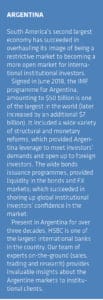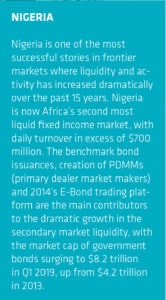
There is more than one definition of frontier markets. Fortunately for the growing range of interested investors, there is also more than one way to access the non-correlated returns and high yields they can offer.
Collectively, frontier markets are economies in an early and often rapid stage of development, but which individually represent very diverse investment opportunities. As an asset class, frontier market debt offers risk-weighted returns that compare favourably with longer-established investments, but there are both higher returns and risks for the discerning investor to explore.
Frontier markets are usually one step removed from powerful headwinds of global investment flows. This is partly due to lower levels of foreign investments than the more traditional emerging markets, and lower levels of corporate, governmental and household debt than developed markets, which makes them less correlated with currency and interest-rate shifts. Furthermore, minimal allocations from passive investments mean frontier markets are less affected by major risk-on/risk-off moves.
However, frontier is no longer synonymous with ‘wild’. Not only are fiscal policies generally more prudent overall, but adherence to governance standards, such as IFRS accounting rules, is also growing. In many cases, less-developed countries have also been quick adopters of services enabled by digital technologies, such as mobile- and cloud-based financial services, without the need to extract legacy infrastructure.
Beyond these group characteristics, almost every frontier market offers its own unique blend of opportunities and risks. From Nigeria to Egypt to Argentina, each country offers a back story that combines a range of factors – demographics, urbanisation rates, infrastructure investment, macro-economic reform, political stability – with the potential to match the alpha profile sought by investors.
Much of the appeal of frontier market debt comes from the carry trade and similar opportunities arising from the currency and interest-rate fluctuations that are an inevitable reality of economic cycles in less-developed markets. In a world of difficult returns in EM and high volatility; both Nigeria and Egypt, for example, have provided steady carry adjusted returns in 2018, respectively 14.68% and 14.83%.
 Whether pursuing carry opportunities or looking for slightly longer-term investments, frontier market debt offers diverse opportunities to those with the necessary research resources. But niche funds have been joined by increasing numbers of larger institutions over the past half-decade, in part driven by under-performance elsewhere, i.e. low yields, high correlations and higher levels of uncertainty and volatility in developed and even emerging markets (EM).
Whether pursuing carry opportunities or looking for slightly longer-term investments, frontier market debt offers diverse opportunities to those with the necessary research resources. But niche funds have been joined by increasing numbers of larger institutions over the past half-decade, in part driven by under-performance elsewhere, i.e. low yields, high correlations and higher levels of uncertainty and volatility in developed and even emerging markets (EM).
As issuance volumes and investor interest rise, so will information flows eventually increase in frequency and quality, addressing widely-held concerns among international institutions over transparency. Inevitably, it will take time for transparency and liquidity levels to improve to levels familiar to global investors in developed markets. Several other risks must also be taken into consideration.
Many frontier markets operate pegged- or semi-pegged currency regimes, which can present issues for foreign investors, in terms of maximising and/or repatriating their investments. Further, the clearing and settlement regimes in most frontier markets can be difficult and costly for non-domestic institutions to connect to or interact with. In some jurisdictions, uncertainty over bondholder rights in the event of default can also dampen investor interest.
Nevertheless, it is becoming much easier for international investors to tap the strong uncorrelated upside stories available in many frontier markets, thanks in part to the dedicated expertise and experience of banks such as HSBC.
Institutional investors partner with HSBC in frontier markets due to the unparalleled length, depth and breadth of our expertise and experience.

From front-office sales and trading coverage, to global research, to middle- and back-office capabilities across risk management, clearing, settlement and custody, and beyond to our on-the-ground relationships and representation, HSBC invests continually with the aim of reducing operational risk and fine-tuning our service to specific investor needs.
As such, our overall capabilities, expertise and relationships in frontier markets are beyond the reach of other global banks. The combined insights and connections that we derive from these deep roots in multiple markets are fundamental to our ability to introduce investors to new markets and opportunities.
Investing in frontier market debt is less of a niche strategy than a decade ago. More institutional investors are seeking and accessing opportunities, due to the development of access products such as TRSs and CLNs. Although part of the attraction of frontier markets is their non-correlated, out-performing returns, the increase in ‘mainstream’ interest does not necessarily limit their overall appeal.
Whether dipping their toe or expand their footprint, we at HSBC stand ready to support all institutional investors as they explore the not-so-wild frontier markets.
